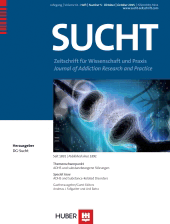Literatur
(2011). DSM-5: Die Aufhebung der Unterscheidung von Abhängigkeit und Missbrauch: Applaus der Forscher [DSM-5: Removal of the distinction between dependence and abuse: applause by researchers], Sucht, 57(1), 50 – 51.
(2010). The Range and Magnitude of Alcohol’s Harm to Others. Fitzroy, Victoria, Australia: AER Centre for Alcohol Policy Research, Turning Point Alcohol and Drug Centre, Eastern Health. [Accessed: 2015 – 08 – 01. Archived by WebCite® at http://www.webcitation.org/5wB6fDhnQ].
(2015). Alcohol dependence and treatment utilization in Europe–a representative cross-sectional study in primary care. BMC Family Practice, 16(1), 90.
(2013). Defining substance use disorders: do we really need more than heavy use? Alcohol and Alcoholism, 48 (6), 633 – 640.
(2015). ICD-11: Was können wir für Suchtforschung und Suchttherapie erwarten? [ICD-11: What can we expect in View of Addiction Research and Addiction Treatment] SUCHT, 61(3), 123 – 126.
(2010). Global strategy to reduce the harmful use of alcohol.Geneva, Switzerland; 2010. [Accessed: 2012 – 08 – 1]. Archived by WebCite® at http://www.webcitation.org/69JCGLnOB].
(2012). Age differences in diagnostic criteria of DSM-IV alcohol dependence among adults with similar drinking behaviour. Addiction, 107(2), 331 – 338.
Literatur
(2014). Basisdokumentation 2013. Ausgewählte Daten zur Entwöhnungsbehandlung im Fachverband Sucht e.V.. Reihe: Qualitätsförderung in der Entwöhnungsbehandlung Band 21. Bonn: Fachverband Sucht e.V.
Literatur
(1985). When luck runs out. New York: Facts on File Publications.
(2014). Impulse control disorders and “behavioural addictions“ in the ICD-11. World Psychiatry, 13, 125 – 127.
(2011). Spielsucht – Ursachen, Therapie und Prävention von glücksspielbezogenem Suchtverhalten(3. Aufl.). Heidelberg: Springer
(2015). The relationsship between the number of types of legal gambling and the rates of gambling behaviors and problems across U.S. states. Journal of Gambling Studies, DOI 10.1007/s10899-015-9551-0.
Literatur
The prognostic implications of DSM-IV abuse criteria in drinking adolescents. Drug Alcohol Depend. 2008 Sep 1;97(1 – 2):94 – 104. doi: 10.1016/j.drugalcdep.2008.03.020. Epub 2008 May 13.
. DSM-5 criteria for substance use disorders: recommendations and rationale. Am J Psychiatry. 2013 Aug; 170(8):834 – 51. doi: 10.1176/appi.ajp.2013.12060782.
. Epidemiology of DSM-5 Alcohol Use Disorder: Results from the National Epidemiologic Survey on Alcohol and Related Conditions III. JAMA Psychiatry. 2015 Jun 3. doi: 10.1001/jamapsychiatry.2015.0584. [Epub ahead of print]
. Scaling properties of the combined ICD-10 dependence and harms criteria and comparisons with DSM-5 alcohol use disorder criteria among patients in the emergency department. J Stud Alcohol Drugs. 2012 Mar; 73(2):328 – 36.
(2015) Diagnostisches und Therapeutsiches Manual Psychischer Störungen DSM-5. American Psychiatric Association. Hogrefe Verlag, Göttingen.
Literatur
(2014). Impulse control disorders and “behavioural Addictions“ in the ICD-11. World Psychiatry, 13, 125 – 127.
(2014). Evaluation of the diagnostic criteria of Internet gaming disorder in the DSM-5 among young adults in Taiwan. Journal of Psychiatric Research, 53, 103 – 111. doi: http://dx.doi.org/10.1016/j.psychires.2014.02.008
(2015). The Internet Gaming Disorder Scale. Psychological Assessment(in press). doi: 10.1037/pas00000062
(2014). Internet- und Computerspielabhängigkeit. In K. Mann (Ed.), Verhaltenssüchte. Heidelberg: Springer.
(2014). An international consensus for assessing internet gaming disorder using the new DSM-5 approach. Addiction, 109(9), 1399 – 1406. doi: 10.1111/add.12457
(2015). Internet Gaming Disorder in the DSM-5. Current Psychiatry Reports, 17(7), in press. doi: DOI 10.1007/s11920-015-0610-0
(2015). Prevalence of Internet Gaming Disorder in German Adolescents: Diagnostic contribution of the nine DSM-5 criteria in a statewide representative sample. Addiction, 110(5), 842 – 851. doi: 10.1002/add.12849
(2015). Internet gaming disorder: A new behavioral addiction. In N. M. Petry (Ed.), Behavioral Addictions: DSM-5® and Beyond (Vol. in press): Oxford University Press.
(2013). Computerspiel- und Internetsucht: Der aktuelle Forschungsstand. Nervenarzt, 84(5), 569 – 575. doi: DOI 10.1007/s00115-012-3721-4
(2015). ICD-11: Was können wir für Suchtforschung und Suchttherapie erwarten? Sucht, 61(3), 1 – 3.
Literatur
(2014). Impulse control disorders and „behavioural addictions“ in the ICD-11. World Psychiatry, 13, 125 – 127.
(2014). Non-Substance addictive behaviors in the context of DSM-5. Addictive Behaviors, 39, 1 – 2.
Literatur
(2015). Report of ICD-11 Revision Review. Consultancy Interim Assessment of 11th ICD Revision. Zugriff am 18. 08. 2015 http://www.who.int/classifications/icd/reportoftheicd11review14april2015.pdf?ua=1
(2007). Diagnostic issues in substance use disorders. Refining the research agenda for DSM-V. Arlington: American Psychiatric Association.
(2011). Old and persistent problems with DSM-5. Addiction, 106, 888 – 889.
(2015). Prevalence of comorbid substance use, anxiety and mood disorders in epidemiological surveys, 1990 – 2014: A systematic review and meta-analysis. Drug and Alcohol Dependence, 154,1 – 13.
Literatur
http://www.awmf.org/uploads/tx_szleitlinien/076-001l_S3-Leitlinie_Alkohol_2015-04.pdf



